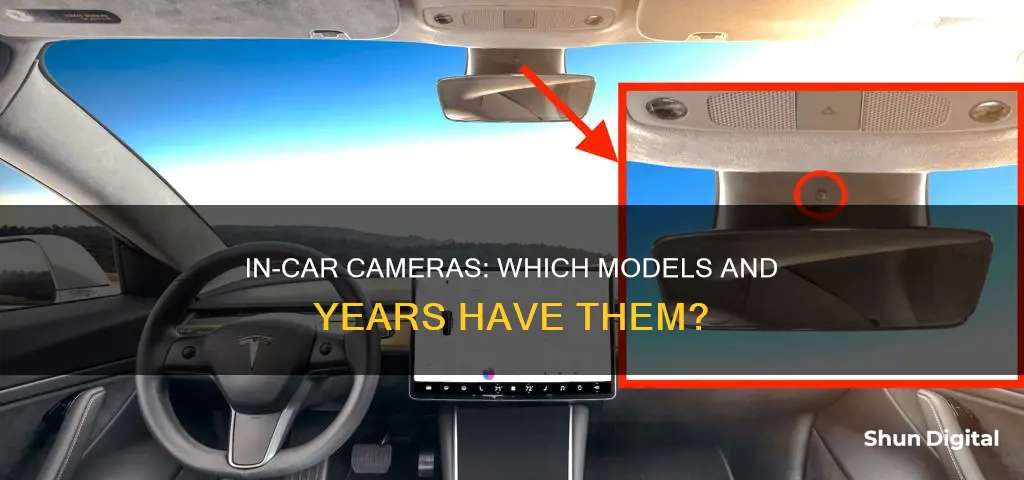
Backup cameras have been standard in all cars and light trucks manufactured for sale in the US since May 1, 2018, due to a federal requirement. Prior to this, many cars were equipped with cameras as either standard or optional equipment. The 2002 Infiniti Q45 sedan was the first car to offer a rear camera in the US, and by the 2015 model year, rear cameras were standard on every Acura, Buick, Honda, and Infiniti vehicle. Other manufacturers, including Ford, Nissan, and Toyota, made them standard before the 2018 federal requirement.
| Characteristics | Values |
|---|---|
| Year rearview cameras became mandatory in the US | 2018 |
| Year backup cameras became mandatory in the US | 2019 |
| Year backup cameras were mandated by the National Highway Traffic Safety Administration | 2014 |
| Year backup cameras became standard in Acuras, Buicks, Hondas, and Infinitis | 2015 |
| Year backup cameras became standard in Fords, Nissans, and Toyotas | Before 2018 |
| Year backup cameras were standard in all Honda models | 2015 |
| Year backup cameras were standard in Toyota Corollas, Camrys, and RAV4s | 2015 |
| Year backup cameras were standard in Honda Civics, CRVs, and Accords | 2016 |
| Year backup cameras were standard in Toyota Corollas | 2017 |
| Year backup cameras were standard in Toyota RAV4s | 2017 |
What You'll Learn

Backup cameras became mandatory in the US in 2018
Backup cameras have been mandatory in all cars and light trucks manufactured and sold in the US since May 1, 2018. This was the result of a federal regulation that required rearview cameras and video displays in all new models. The National Highway Traffic Safety Administration (NHTSA) had mandated this in 2014, giving automakers several years to prepare.
The regulation was a response to safety concerns, with thousands of pedestrians injured and over 200 killed annually in accidents where drivers backing up couldn't see them, including many children. Backup cameras were expected to save lives and reduce injuries, especially among children and seniors.
While backup cameras are now standard, even in the cheapest of new cars, car dealers may still advertise them as an added luxury or special option and charge extra. However, consumers should be aware that backup cameras are a legal mandate, like seat belts or airbags, and not an optional extra.
The requirement for backup cameras typically applies to new passenger vehicles, trucks, buses, and multipurpose passenger vehicles with a gross vehicle weight rating (GVWR) of 10,000 pounds or less. It is important to note that this requirement only applies to vehicles manufactured after 2018, and older vehicles are not required to have backup cameras installed.
The Evolution of Computer Cameras: How Are They Made?
You may want to see also

The 2002 Infiniti Q45 was the first US car with a rear camera
Rearview cameras have become an essential feature in modern cars, enhancing both convenience and safety. While backup cameras have been available as optional equipment for many years, there was a significant push to make them standard across all vehicles. In the United States, this push culminated in a federal requirement mandating that all cars and light trucks manufactured for sale from May 1, 2018, onwards must be equipped with backup cameras. This legislation was driven by safety advocates who recognised the life-saving potential of these cameras, particularly in preventing accidents involving pedestrians during reversing manoeuvres.
Prior to the federal mandate, several automakers had already begun integrating rearview cameras into their vehicles. One notable example is the 2002 Infiniti Q45, a luxurious and technologically advanced sedan. The Q45 was a significant model for Infiniti, representing a comprehensive redesign and rethinking of their flagship performance luxury sedan. The 2002 Q45 introduced a host of new features and improvements, including a powerful new 340-horsepower, 4.5-liter V-8 engine, sophisticated traction control systems, and high-end electronics.
Among these innovations, the inclusion of a rearview camera, or Rear View Monitor, as an optional feature, marked a significant step forward. For an additional cost, buyers could opt for the Premium Package, which included the Rear View Monitor, a video screen that displayed what was behind the car, aiding in parking and manoeuvring. This feature was a precursor to what would eventually become standard in all new vehicles sold in the US by 2018. The camera was positioned near the rear license plate, and the image was displayed on a dashboard screen, along with lines to assist with parking.
The introduction of the rearview camera in the 2002 Infiniti Q45 highlighted the growing importance of driver assistance technologies and set a precedent for other automakers to follow. While the Q45 was not the first car ever to feature a rearview camera, as that distinction goes to the 1991 Japanese-market Toyota Soarer coupe, it was the first to offer this feature in the United States. This distinction solidifies the Q45's place in automotive history and showcases Infiniti's commitment to innovation and safety.
Camera Battery Leak: What You Need to Know
You may want to see also

Rear cameras are now standard in most cars
Rearview cameras have been standard in all cars and light trucks manufactured for sale in the US since May 1, 2018, thanks to a federal requirement. This means that if you're looking to buy a used car, you'll want to look at models from 2018 onwards to guarantee this feature.
The rearview camera has been a long time coming. Congress passed the Cameron Gulbransen Kids Transportation Safety Act in 2008, named after a child killed when an SUV backed into him in 2002. The bill stipulated that the Department of Transportation had to issue a backup camera law within three years. After years of setbacks, several safety groups sued the DOT, citing an "unreasonable delay" in creating the necessary rules. Safety advocates quickly focused on the potential for rearview cameras to save lives, particularly those of children, as thousands of pedestrians were injured and killed in accidents each year where drivers were reversing without a clear view.
The first car with the potential for a rearview camera was the 1956 Buick Centurion concept car, which had a rear-mounted camera that sent images to a dashboard screen. However, it wasn't until 35 years later that the first production model with a rearview camera debuted: the 1991 Japanese-market Toyota Soarer coupe. It took another 11 years for a vehicle with backup camera technology to become available in the US, with the 2002 Infiniti Q45 sedan.
By the 2015 model year, rearview cameras were standard on every Acura, Buick, Honda, and Infiniti vehicle. Other automakers, including Ford, Nissan, and Toyota, made them standard ahead of the 2018 federal requirement.
Today, modern reverse systems often provide audible warnings and even automatic braking if the car that is reversing is in the path of other vehicles or objects, such as pedestrians or bicycles. The combination of a rearview camera with rear parking sensors has been shown to reduce the backup collision rate by 42%. Adding automatic rear braking to the camera and parking sensors lowers the collision rate by 78%.
Battery-Powered Wi-Fi Cameras: Night Vision Included?
You may want to see also

Backup cameras can reduce collisions by 5%
Backup cameras have been standard in all cars and light trucks manufactured for sale in the US since May 1, 2018, thanks to a federal requirement. The National Highway Traffic Safety Administration (NHTSA) passed this rule in 2014 to reduce the number of back-over accidents, which cause hundreds of deaths and thousands of injuries each year.
While backup cameras can help prevent accidents, they are not a silver bullet. A 2019 study by the Insurance Institute for Highway Safety (IIHS) found that backup cameras alone reduced collision rates by only 5%. However, when combined with rear parking sensors, the backup collision rate was reduced by 42%. Adding automatic rear braking to the camera and parking sensors lowered the collision rate by 78%.
The effectiveness of backup cameras can be limited by several factors. Firstly, not all backup cameras are created equal, and some lower-end cameras may have limited capabilities and image quality. Secondly, drivers may not always use the cameras or may rely too heavily on them, leading to distracted driving. It is important for drivers to understand the limitations of their vehicles' cameras and to continue using mirrors and turning around to look when backing up.
Despite these limitations, backup cameras have likely contributed to a reduction in back-over accidents. Data from the NHTSA shows that injuries from backup accidents fell by 8% between 2008 and 2011, while fatalities from such accidents dropped by 31% during the same period. Organizations like Kids and Cars have also reported a steady decline in deaths among children due to back-over accidents, which is likely due at least in part to the increasing prevalence of backup cameras and other safety features.
Samsung S5 Camera Focus: Poor Performance, Why?
You may want to see also

Some cars have cameras mounted in retracting elements
Backup cameras have been standard in all cars and light trucks manufactured for sale in the US since May 2018. This was due to a federal requirement, which was also implemented in Canada. Before this mandate, many cars were equipped with cameras as either standard or optional equipment.
The first production car to feature a backup camera was the 1991 Toyota Soarer Limited, which was only available in Japan. Infiniti was the first automaker to offer a rear camera in the US on the 2002 Q45 sedan.
Backup cameras are designed to be attached to the rear of a vehicle to aid in reversing and reduce the rear blind spot, which has been described as a "killing zone" due to the number of accidents it contributes to.
Some car manufacturers have placed cameras inside retracting elements, such as a motorized trunk logo on Volkswagen models. This design exposes the lens only when the car is in reverse, keeping it tucked away from dirt and precipitation at other times.
In addition to backup cameras, some vehicles have other features to assist drivers when in reverse. These include rear parking sensors, which sound an alarm that increases in frequency as the vehicle gets closer to another object. Some cars also have a rear cross-traffic alert, which senses traffic approaching from either side when reversing, and automatic rear braking, which can apply the brakes to avoid a collision.
Focusing High-Power Microscope Cameras: Tips and Tricks
You may want to see also
Frequently asked questions
All cars and light trucks manufactured for sale in the U.S. since May 1, 2018, have come with backup cameras.
Yes, some cars had cameras before 2018, either as standard or as optional equipment. The 2002 Infiniti Q45 sedan was the first car to have a rear camera in the U.S.
Backup cameras are used for parking assistance and have also saved lives. They can see blind spots that traditional rearview mirrors cannot.







